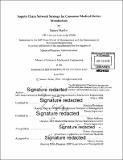| dc.contributor.advisor | Dimitris Bertsimas and Brian Anthony. | en_US |
| dc.contributor.author | Haidar, Samer, S.M. Massachusetts Institute of Technology | en_US |
| dc.contributor.other | Leaders for Global Operations Program. | en_US |
| dc.date.accessioned | 2016-09-13T19:24:11Z | |
| dc.date.available | 2016-09-13T19:24:11Z | |
| dc.date.copyright | 2016 | en_US |
| dc.date.issued | 2016 | en_US |
| dc.identifier.uri | http://hdl.handle.net/1721.1/104310 | |
| dc.description | Thesis: M.B.A., Massachusetts Institute of Technology, Sloan School of Management, 2016. In conjunction with the Leaders for Global Operations Program at MIT. | en_US |
| dc.description | Thesis: S.M. in Engineering Systems, Massachusetts Institute of Technology, Department of Mechanical Engineering, 2016. In conjunction with the Leaders for Global Operations Program at MIT. | en_US |
| dc.description | Cataloged from PDF version of thesis. | en_US |
| dc.description | Includes bibliographical references (pages 97-99). | en_US |
| dc.description.abstract | This thesis presents an optimization framework to model the trade-offs in strategic supply chain decision-making for a new product introduction in a real-world setting. The focus of the thesis is on a consumer medical device that Johnson & Johnson's Calibra business will launch in the future. As with any new product introduction, the launch exposes the J&J business to risk and uncertainty. We develop a mixed-integer optimization model to guide the optimal design of a global consumer medical device supply chain network comprising component suppliers, assembly facilities, sterilizers, and distribution centers. The model evaluates strategic decisions over a seven-year time horizon related to the location and capacities of various supply chain facilities and partners, transportation costs, and strategic inventory required to satisfy global demand. We developed a stochastic optimization extension of the model to protect the supply chain decision maker from demand uncertainty. Comparison of the output of the model assuming deterministic demand to a managerial heuristic resulted in total supply chain network cost reductions of 19% - 27%, amounting to hundreds of millions in present-value dollars. The stochastic optimization solution reduces infeasibility related to either not meeting the demand or transportation lead time constraints. The two models presented in this thesis enable J&J supply chain decision makers to gauge the additional costs and benefits of different network design concepts, develop a network strategy that can adapt to uncertain demand, and create a strong strategic foundation for future tactical and operational decisions. | en_US |
| dc.description.statementofresponsibility | by Samer Haidar. | en_US |
| dc.format.extent | 99 pages | en_US |
| dc.language.iso | eng | en_US |
| dc.publisher | Massachusetts Institute of Technology | en_US |
| dc.rights | M.I.T. theses are protected by copyright. They may be viewed from this source for any purpose, but reproduction or distribution in any format is prohibited without written permission. See provided URL for inquiries about permission. | en_US |
| dc.rights.uri | http://dspace.mit.edu/handle/1721.1/7582 | en_US |
| dc.subject | Sloan School of Management. | en_US |
| dc.subject | Mechanical Engineering. | en_US |
| dc.subject | Leaders for Global Operations Program. | en_US |
| dc.title | Supply chain network strategy for consumer medical device introduction | en_US |
| dc.type | Thesis | en_US |
| dc.description.degree | M.B.A. | en_US |
| dc.description.degree | S.M. in Engineering Systems | en_US |
| dc.contributor.department | Leaders for Global Operations Program at MIT | en_US |
| dc.contributor.department | Massachusetts Institute of Technology. Department of Mechanical Engineering | |
| dc.contributor.department | Sloan School of Management | |
| dc.identifier.oclc | 958278800 | en_US |
